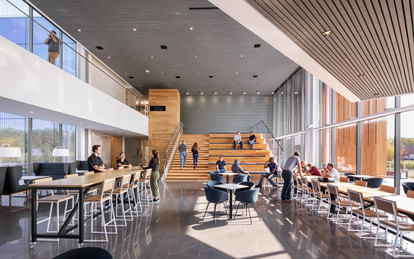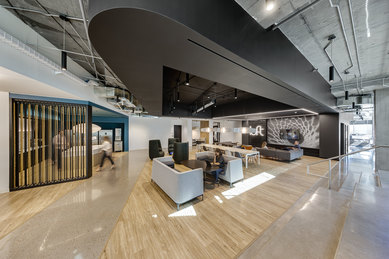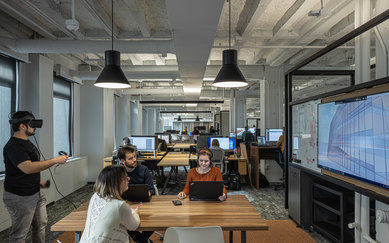Evolutions in Workspace Design

This article was originally published in Work Design Magazine as a two-part series.
In Part I of this series, we discussed widespread adoption of the virtual office and the implications to organizations around the world. That said, the physical workplace will remain a strong, steadfast component in the world of work. C-suite leaders must be deftly aware—now more than ever—the workplace cannot be viewed simply as an operational cost of doing business. It is a valuable strategic asset—a tool that fosters and supports an organization’s goals and propels it forward. And this power hinges on an office’s ability to unify and rally individuals around a shared purpose and vision. But why?
Humans thrive on relationships and the physical presence of one another. Face-to-face interaction is information rich. Facial expressions, vocal cues, physical movements, and other non-verbal feedback enhance interaction and the sharing of ideas. Some believe that true innovation can only take place when people of diverse perspectives come together. The office is a wonderful tool for accomplishing these work-related objectives and so much more.
Workplace Design Models: Finding the Right Fit
As companies dig into to the future state of work within their own organizations, numerous workplace models will be examined, including satellite offices; hub-and-spoke models; networks of smaller, lower-cost office spaces closer to employees’ homes, to name a few. At the same time, the home office market will also grow exponentially. In fact, we have already seen a handful of office furniture manufacturers pivot to direct-to-consumer marketplaces. Regardless of the model, we remain confident that design solutions will revolve around the employee experience, with a keen eye on flexibility and choice, technology, sustainability and wellbeing, inclusion, and diversity—all culminating into culture-driven environments.
Still, there remains no “one size fits all” solution to workplace design. Strategists and designers must focus intently on getting to the unique, underlying “why” driving in-office work at each organization. Defining this important factor will enable teams to create appropriate, future-focused solutions that ensure an organization’s workplace remains an extension of a client’s business strategy.
Flexibility, Choice & Scalability
In addition to altering perspectives regarding where, when, and how employees work, COVID-19 also gave renewed importance to the benefits of flexibility within physical spaces. As we reimagine the future of work, organizations that can learn from the challenges the pandemic ignited and plan for the ability to seamlessly execute enterprise-scale transitions—such as changeover from office-based to work-from-home modalities—will come out ahead on multiple fronts.
Moving forward, flexibility and choice will remain critical to managing both staff and space. Furniture solutions, floor plans, circulation paths and multi-use spaces that can be reconfigured quickly and easily will increase in importance. Within our physical workspaces, empowering employees to control certain aspects of their physical workspace will remain a priority. As a result, unassigned seating that enables staff to choose from a variety of activity-based settings—from open bench workstations to café style environments, privacy cubbies and more—will continue to grow in popularity. For clients that are comfortable moving further down the flexibility/choice continuum, the integration of hackable furniture solutions and open, reconfigurable spaces will give employees and teams the opportunity for even more control. The more progressive that companies choose to be on the flexibility continuum, the better they will fare when competing for talent.
Technology that Untethers & Equalizes
The COVID-19 pandemic reminded us that technology should not simply enable effective work but propel it forward. In the physical office, technology can help to untether us and remove friction from both work and movement throughout the workspace, with platforms that allow sharing of data and files in real-time to intuitive workstation and room scheduling tools that allow users to flow seamlessly within a space.
Technology also needs to equalize. With a projected increase in hybrid work—where employees work both virtually and on-site after the pandemic subsides—we must keep remote teammates from being mere observers when other team members are together in person. More open and virtually connected collaboration spaces that blur the boundaries between remote and in-office teams will rise, as will new ways to connect virtually.
We will also continue to see a rise in requests from employees seeking greater access to information. Information sharing via dashboards will continue to gain popularity, as employers adopt platforms that enable everything from the sharing of building systems information and tracking of space and energy utilization rates, to reserving desks, meeting spaces, parking spaces, and so much more.
Sustainability & Wellbeing
Research shows that physical spaces have a profound impact on people and their wellbeing. Advancing and increasingly accessible science can unlock even greater potential in an organization’s most valuable asset: its people. We understand and can now quantify human impacts derived from access to daylight, fresh air, high-quality food, physical activity and more. Ensuring this science is represented in new design strategies poses a great opportunity to increase employee engagement and enhance creativity at a time when people need it most.
Moving forward, cleanable fabrics with less texture and bleachable surfaces will be specified. In addition, operable windows, shading controls, MERV-15 filters, increasing outside air to spaces, increasing minimum relative humidity, in-duct UV-C light systems, bipolar ionization, and FAR UV lights will be more widely adopted.
Inclusion & Diversity
It takes time, resources, and courage to create a workplace culture that understands the holistic impact equity, diversity and inclusion have in raising the value of our collective work. Efforts centered around advancing equity, diversity and inclusion are helping organizations engage in deeper and more meaningful conversations, initiatives, and actions to minimize barriers and promote these values.
New design endeavors must truly position all team members, regardless of race, gender, age, physical disability, or mental illness to succeed and feel valued. Having surveyed thousands of U.S. office workers in the last 12 months, one benefit consistently cited from working remotely was the lack of office distractions. We cannot ignore the employee’s desire for quiet, focused work time once we return to the office. Small moves like quiet zones and heads down space will go a long way in bridging that gap of office liveliness and solo productivity.
Culture-Driven Environments & Policies
The famous quote from Peter Drucker, “culture eats strategy for breakfast,” rings truer today than ever before. As the COVID-19 pandemic subsides and we return to certain levels of normalcy, the role of human resources will be amplified within the workplace. Revised office etiquette protocols, medical privacy concerns and guidelines, revised performance review criteria and recruitment postings will become more granular, with expected amounts of time to be spent in the office as a criterion.
Companies need to focus on building a culture based upon trust, empathy, and equity among all employees, all while promoting a healthy work/life balance. Companies that establish ground rules, realistic expectations, and acknowledge the whole employee will come out ahead.
Looking to the Future
The last 12 months have reminded us that the world—and work—can change in a blink. The pandemic has impacted nearly every aspect of our lives and livelihoods, and the long-term implications are yet to be revealed. As companies explore how these changes will impact the future of work within their organizations, policies and practices centered on flexibility and empowerment will be critical moving forward. Additionally, office spaces that center on the employee experience while also supporting health and wellbeing will play a central role in building culture and recruiting and retaining top talent. It will not necessarily be an easy path forward, but leaders that effectively balance this unique range of drivers and criterion will position their employees and organizations for future success.
If this conversation resonates with you, please fill out the form below to learn how SmithGroup can help solve your company’s challenges.


